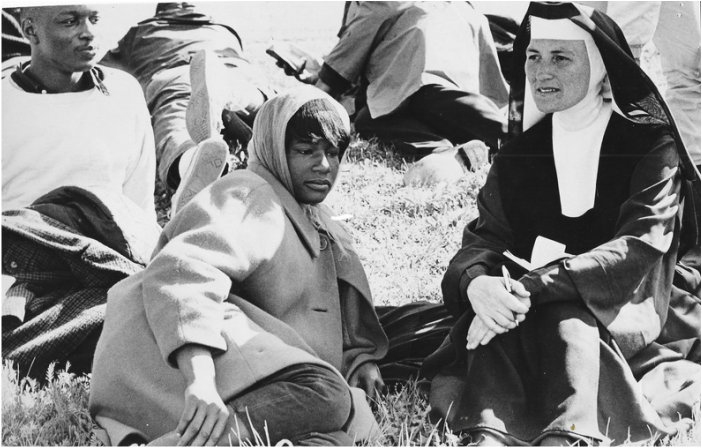Sr. Eugenia Ward, left, treasurer; Sister Mary William, middle, President of Immaculate Heart College; Sister Mary Humiliata, President of Immaculate Heart Community during the years of transition. Photo courtesy of IHC Archives.
Our Roots, Our Story
In 1848, Canon Joaquin Masmitja de Puig, in response to the spiritual, educational, and social needs of young women challenged by living in wartime Spain, founded the Daughters of the Most Holy and Immaculate Heart of Mary in Olot, Catalonia. By 1868, their reputation as skilled educators prompted Bishop Amat of California to invite them to found an educational apostolate in Los Angeles. In 1871, ten pioneer sisters arrived in California and were assigned to several locations before ultimately arriving to work in Los Angeles itself.
When Saint Vibiana Cathedral School opened in 1886 in the center of Los Angeles, IHM sisters staffed the school. In 1906, the sisters opened the Immaculate Heart Convent and Immaculate Heart High School on Franklin Avenue in Los Angeles. In 1916, they chartered and opened Immaculate Heart College on the same property. In 1924 they became independent of Spain and formed a Pontifical Institute aligned with American customs and sensibilities.
The decades following their independence from Spain were self-defining for the Immaculate Heart Sisters. They opened a Novitiate and Retreat Center in Montecito, began hospital ministries, and staffed many Catholic elementary schools and Catholic high schools. Gradually, over the next few decades their service extended beyond California to include schools in Texas, Arizona and Canada. Innovation, creativity and hospitality were hallmarks that characterized the broad scope of their ministries and their service to communities.
From 1962-1965, the Second Vatican Council focused on the renewal of the Catholic Church including women’s and men’s religious communities around the world. The Council called for more effective ways to respond to newly emerging needs for service and for the revitalization of the connection between people and Church. Responding to the changes prompted by Vatican II and moved by contemporary philosophies, modern psychology and evolving feminist consciousness, the Immaculate Heart Sisters embraced the call to transformation.
Sister Patrice Underwood, IHM, rests with a fellow justice advocate during the 1965 March to Selma, Alabama with Dr. Martin Luther King. Photo courtesy of Anita M. Caspary Trust.
Over a two-year period, community leaders initiated and engaged the Sisters in a deeply reflective study that focused on the structure of their lives, the people they served and their place in the changing world. Their study defined obstacles that impeded their efficacy and ways that they might transcend these obstacles. Eminent theologians spoke to them about the meaning of the Council documents and the process of bringing forth renewal in themselves and in their work.
When the study was complete, an elected group of IHMs gathered in Montecito to develop the response called for by the reforms of Vatican Council II. By 1967 they felt secure in their decisions regarding flexible prayer times, contemporary dress and expanding their ministries beyond health and education, as well as the commitment to professional formation for educators.
This response, though prayerfully presented, was met with opposition and animosity from Church officials, escalating to an irreconcilable impasse. The IHMs chose to remain true to the integrity of their renewed vision and formed an independent community, without canonical status, guided by the Decrees created in 1968.
This conflict precipitated the division of the Immaculate Heart Sisters into two groups: those who chose to stay in canonical status and continued to live under the jurisdiction of the Los Angeles Archdiocese, and those who elected to live independently and form the community that exists today as the Immaculate Heart Community.
In 1968, those IHMs who held teaching positions in Catholic schools throughout the Archdiocese of Los Angeles were involuntarily removed from their responsibilities. In other dioceses Community members continued to teach in parochial elementary schools and high schools under more sympathetic Church administrators. What had previously been IHM ministries became separate non-profit corporations, including Immaculate Heart College, Immaculate Heart High School, Queen of the Valley Hospital, and La Casa de Maria Retreat Center. As a spiritual community desirous of continued service in the world, the Community, under its new name, Immaculate Heart Community, re-designated itself as a public benefit corporation in the state of California in 1970.
Books about the Immaculate Heart Community
Ault, Julie. (2006). Come Alive! The Spiritual Art of Sister Corita. London: Four Corners Books.
Berry, Ian and Duncan, Michael (Eds.). (2013). Someday is Now: The Art of Corita Kent. New York: Prestel Verlag.
Cano, Nan Deane, IHM (2016). Take Heart: Growing as a Faith Community. New York: Paulist Press.
Caspary, Anita M., IHM, (2003). Witness to Integrity: The Crisis of the Immaculate Heart Community of California. Collegeville: University Press.


